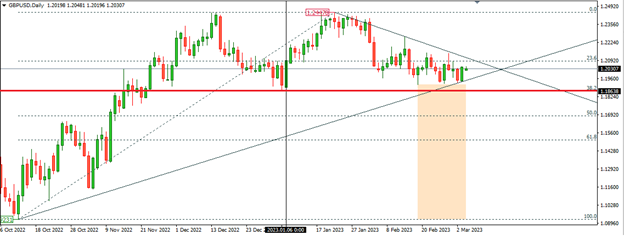A Guide To Trading The GBPUSD

Lorem Ipsum
The GBPUSD currency pair is one of the most popular trading instruments in the forex market. Due to its high liquidity and volatility, it attracts significant interest from forex traders worldwide. In this guide, we will provide an overview of the characteristics of the GBPUSD pair, including important factors that influence its price movements. We'll also provide valuable insights and practical tips for trading GBPUSD.
Who trades the GBP/USD?
A diverse range of market participants, including banks, hedge funds, retail traders, multinational corporations, and central banks, actively trade the GBPUSD. These participants use a variety of trading strategies, including fundamental and technical analysis, to profit from price movements in the market. The GBP/USD is highly liquid and volatile, with various factors influencing its price movements. To trade the GBP/USD effectively, traders must stay informed about these factors and use effective risk management strategies. By understanding the market dynamics and employing appropriate trading strategies, traders can make informed decisions and potentially profit from trading the GBP/USD.
What Major Factors Influence The GBP/USD?
Economic data releases, monetary policy decisions, political developments, and geopolitical events in the UK and the US are some factors that affect the currency pair's value. Here are some major factors that can influence the GBP/USD:
For the GBP side in the FX Pair:
- Economic data releases: The release of economic indicators such as GDP, inflation, employment, retail sales, and trade data can impact the value of the British Pound. Strong financial data releases typically lead to a stronger GBP, while weak data can weaken the currency.
- Monetary policy decisions: Interest rates and the amount of quantitative easing implemented in the United Kingdom are both products of monetary policy, which the Bank of England determines. The British Pound's value may be affected by shifts in monetary policy, such as interest rates.
- Trade flows: Trade balances and changes in the volume of trade can impact the value of the GBP. For example, a decrease in exports can lead to a weakening of the currency.
- Investor sentiment: Changes in investor sentiment towards the UK economy or political situation can also impact the value of the GBP.
- Capital flows: The flow of money in and out of the UK can impact the value of the GBP. For example, if foreign investors are selling UK assets, it can weaken the currency.
For the USD side in the FX Pair:
- Interest rates: The Federal Reserve sets monetary policy for the US, including interest rates. Higher interest rates typically lead to a stronger USD, as higher yields attract investors.
- Geopolitical events: International conflicts, trade agreements, and other global events can impact the USD. For example, changes in oil prices and other commodities can influence the value of the USD. Similarly, trade policies and tensions with other countries can influence the value of the USD.
- Safe-haven status: The USD is often considered a safe-haven currency during economic uncertainty or political turmoil. In these situations, investors may flock to the USD, leading to a strengthening of the currency.
What do Price changes in the GBP/USD Mean?
The GBP/USD is a currency pair representing the exchange rate between the British Pound (GBP) and the US dollar (USD). Price changes in the GBP/USD reflect each currency's relative strength or weakness regarding the other.
Generally speaking, when the GBP/USD exchange rate increases, it means that the British Pound has strengthened against the US Dollar or that the US Dollar has weakened against the Pound. Conversely, when the exchange rate decreases, the British Pound weakens against the US Dollar or the US Dollar strengthens against the Pound.
The magnitude of price changes in the GBP/USD can vary widely depending on various factors, such as economic data releases, political events, central bank announcements, and market sentiment. In general, the currency markets are highly volatile and subject to rapid price movements, making it difficult to predict future price changes in the short term.
However, the GBP/USD exchange rate tends to be influenced by broader economic trends and the relative strength of the UK and US economies over the long term. In particular, factors such as interest rate differentials, inflation rates, and trade balances can significantly impact the exchange rate over time.
Reading a GBP/USD Price Chart
Currency traders examine the GBP/USD price chart to gain insight into the currency pair's recent and historical trends. The chart can indicate resistance and support levels by monitoring the current price data.
Remember, the chart's time frame determines the longevity of certain levels. For instance, the support level on a daily chart will hold for numerous days, even weeks. On the other hand, a support level shown on a 1-hour chart will only be relevant for a few trading hours at most.

This is a daily price chart for the GBPUSD. You can see that the red line, representing a resistance level, has been breached. After that, the resistance line became the support level. The market then tried for a breakthrough on Jan 06, 2023, but was rejected by the newly established support level.
Tips for trading the GBP/USD using Fundamental Analysis
Using fundamental analysis, you must analyse economic and political factors that can affect the value of the British Pound (GBP) and the US Dollar (USD) when trading GBP/USD. Let's share some tips on how to do so.
1) Economic indicators such as GDP, inflation, employment, and interest rates can significantly impact currency values. Keep an eye on the Bank of England and the Federal Reserve for any shifts in monetary policy, and monitor the release of economic data from both countries.
2) Keep an eye on political developments in both countries and geopolitical tensions that could affect the GBP/USD exchange rate.
3) Stay informed about news and events that could affect market sentiments, such as changes in global economic conditions or central bank announcements. Monitor social media and news sources for developments impacting the GBP/USD.
Tips for trading the GBP/USD using Technical Analysis
Trading the GBP/USD using technical analysis involves analysing price charts and using technical indicators to identify potential entry and exit points. Here are some tips for trading the GBP/USD using technical analysis:
1) Look for levels where the price has repeatedly bounced off, indicating that they may act as support or resistance in the future. These levels can help you identify potential entry and exit points.
2) Trend lines can help you identify the direction of the trend and potential reversal points. Draw trend lines connecting the highs or lows of the price to identify potential support or resistance levels.
3)Technical indicators such as moving averages, RSI, MACD, and Bollinger Bands can help you identify potential entry and exit points. Experiment with different indicators to find the ones that work best for you.
Bottom Line
Trading the GBPUSD can be a lucrative opportunity for traders willing to research, stay up-to-date on news and events, and utilise effective trading strategies. It is important to remember that the GBPUSD is a volatile currency pair, which can result in both large gains and losses. Therefore, traders should always manage risk using appropriate stop loss and take profit levels to protect their capital. By following the guidelines outlined in this trading guide, traders can increase their chances of success when trading the GBPUSD.
More Trading Guides:


